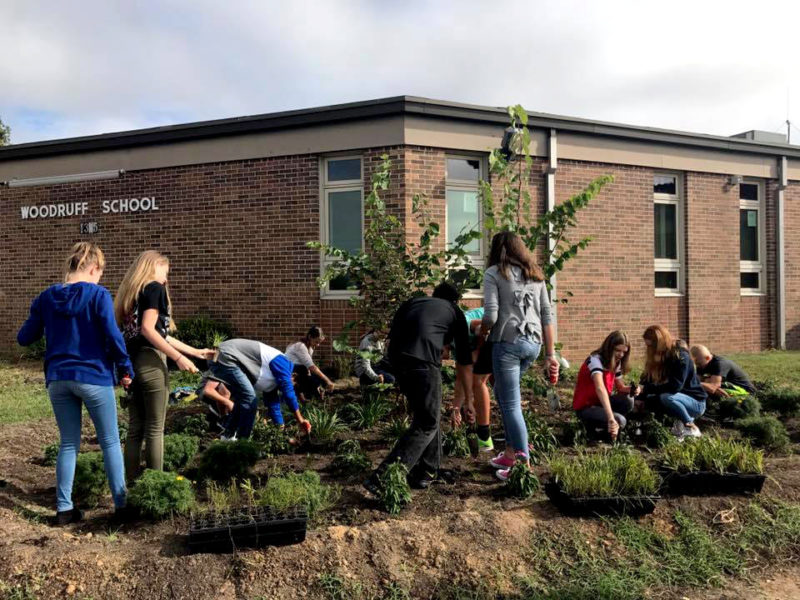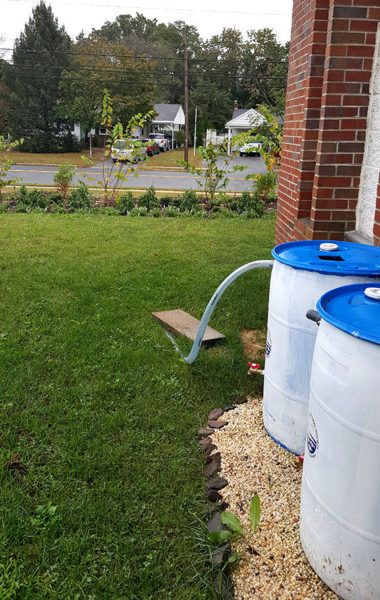Rain Gardens and Green Infrastructure
Green stormwater infrastructure (GSI) is when vegetation, soils, and other elements and practices are used to restore some of the natural processes required to reduce water pollution.
Educators are always looking for ways to engage and inspire their students. By giving students hands-on learning opportunities, rain gardens and other green stormwater infrastructure (GSI) provide an excellent way to get students excited about school. Additionally, with rain gardens and GSI, students can learn while also helping to protect the natural resources in the local community.
What is green stormwater infrastructure (GSI)?
Green stormwater infrastructure (GSI) is when vegetation, soils, and other elements and practices are used to restore some of the natural processes required to reduce water pollution and improve the health of our local environment.
In natural spaces, like forests and wetlands, when it rains, the water is used by plants and filtered into the ground in a pristine and unpolluted state. In urban and suburban areas, however, when the rain falls, the stormwater runs over developed surfaces and picks up pollutants, like pesticides and pet waste. The stormwater then carries these pollutants with it when it flows into local streams, rivers, and lakes. This pollutes our waterways, negatively impacting wildlife as well as our own drinking water. GSI can help prevent this outcome.

Installing GSI, such as rain gardens or planter boxes, is an attempt to mimic the processes of natural spaces but in an urban environment. These installations help to conserve, redirect, and filter polluted stormwater so it doesn’t enter local bodies of water.
What are some examples of GSI that can be used in schools?
Schools, as pillars of the community, provide the perfect space for installing GSI. At schools, GSI can serve as an educational tool for the students as well as for the larger community. There are many options for schools who want to go green and install GSI. Here are a few examples:
- Green Roofs. If you have roof accessibility or have the ability to create rooftop accessibility, you can start a rooftop garden. These are especially cost-effective for schools in dense urban areas.
- Urban Tree Canopy. Trees have the ability to reduce and slow stormwater. They intercept precipitation by catching rainwater on their leaves and branches. You can involve the whole community in planting trees.
- Rain barrels. Rain barrels are large buckets that collect rainwater from roofs. They are typically connected to the gutter or downspout. This prevents stormwater runoff. Students can paint the barrels and help with their installation.
- Planter Boxes. This is a great option for dense urban areas where a typical rain garden may not be feasible and where space is limited. Planter boxes are essentially urban rain gardens. Greenery is planted in boxes with either open or closed bottoms. These boxes collect runoff from roofs, sidewalks, and streets.
- Rain gardens. Rain gardens, discussed in more detail below, are gardens specifically designed to collect rainwater and reduce runoff. They are versatile and can be installed in almost any unpaved space.
What is a rain garden?

A rain garden is a depressed plot of land where native grasses, flowers, and shrubs are planted. The garden helps to reduce local water pollution. When rain falls, the stormwater runs over developed surfaces and picks up pollutants, like pesticides and pet waste. The stormwater then carries these pollutants with it when it flows into local streams, rivers, and lakes.
Rain gardens interrupt this process. The polluted stormwater instead gathers in the garden. The plants in the garden filter and clean the water, removing the pollutants. The water then flows into the ground where it then heads to local aquifers in a cleaner state.
Why should I install a rain garden at my school?
Rain gardens provide many benefits for students, the community, and the environment. Here are just a few reasons to install a rain garden at your school:
- Hands-on learning opportunities. Rain gardens provide students with hands-on opportunities in many different subjects, including math, science, and even literacy. Many of the rain garden lesson plans are in line with federal and state standards. For some examples of rain garden lesson plans, click here.
- Reduce your school’s ecological footprint. As previously mentioned, rain gardens make a big impact in reducing water pollution, thus enabling your school to become more eco-friendly.
- Help students develop both hard and soft skills. Having gardens in schools has been shown to improve students’ skills in science and health as well as their social-emotional schools. Gardens have been found to improve students’ self-confidence, emotion-management, and initiative.
- Educate students and the public about water pollution. Schools are often a place of education for the entire community. Having a rain garden at your school can help inform local residents about the importance of water conservation and protection.
- Build community. The process of building the rain garden can be school-wide or even community-wide. It allows students, educators, and families to work together to accomplish a common goal, thus uniting the community in the pursuit of a more ecologically-friendly neighborhood.
How can I install a rain garden at my school?
Installing a rain garden at your school is easier than you might expect. With proper planning, solid partnerships, and sufficient organization, you, too, can plant a rain garden at your school. Here are some tips to help you get started:
- Get organized. Setting goals, making a plan, and forming a team are three of the most important steps to installing a rain garden. Getting organized at the start of the project can prevent issues later. This manual can help you get started.
- Budgeting. You’ll need to consider costs of plants, designing, and any materials. Typically, the plants are the highest cost. Check with local nurseries to get prices on plants. Some may be open to donating plants for the project. You can also hold a fundraiser or apply for grants for help with funding your garden.
- Look for partners/organizations. There are organizations in New Jersey that can help you with the process of getting a rain garden installed in your school. The Rutger’s Water Resources program is a good place to start.
- Design and site location. When selecting a location, you should consider where the water will enter and where it will flow out. Contact a local landscaper or your partner organization to help you determine the design and location of your garden. If you decide to do this yourself, see this manual for help.
- Planting day. Planting a rain garden is often a school-wide community event. It’s a fun day, but it also requires some planning. Be sure that everyone involved knows what their roles are and that all the materials and plants are prepared. See this Rain Garden Manual for a sample planting day checklist.
Additional Resources
The following resources can give you more information on rain gardens and GSI, so your school can go green:
